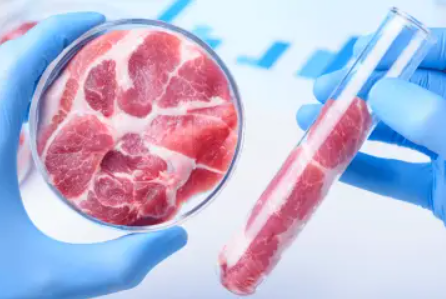Despite its image as a sustainable alternative to cattle production, research has raised concerns regarding lab-grown meat’s environmental impact.
A group of academics from UCD and Holtville University in California conducted a study that looked into the potential drawbacks of current cultured meat manufacturing technologies.
Their research revealed that lab-grown meat production may emit more CO2 per kilogramme of meat than normal cattle, depending on the techniques used by the company.
Lab-Grown Meat Is More Complex than You Can Imagine
Meat generated in Petri plates needs the transformation of animal cells into edible tissues such as connective tissues or fat.
This technology requires less water, land, and chemicals, yet the production process has environmental effects due to the nutrients required for lab meat growth.
The technique entails collecting growth factors from animal serums and cultivating crops for vitamins and carbohydrates. All of this increases the environmental footprint.
Furthermore, high-quality ingredient purification requires a lot of energy, which is essential for preventing microbiological contamination.
A Balance Between the Impact on the Environment & Technological Advancements
By reducing the energy requirements for purification to a food-grade standard, greenhouse gas emissions from lab meat production can be reduced by more than a fifth compared to traditional cattle farming.
With the correct conditions, lab-grown meat might be up to 80 percent more environmentally friendly than cattle production.
However, experts emphasise that significant technological breakthroughs are required to improve performance and reduce costs connected with cell-based meat production.
Could the Key to a Sustainable Future Be a Reevaluation of Priorities?
Currently, the idea is that investing in livestock farm efficiency may be a more effective way to reduce the environmental impact of meat production.
These approaches may result in a greater immediate decrease in emissions than the lab-grown meat business. The cultured meat industry can be examined in terms of its environmental impact.
The sensitive nature of animal cell cultures necessitates specialised and energy-intensive bioreactors, which add to the industry’s environmental impact.
The researchers emphasise the need of focussing on the major concerns and overcoming technological challenges before increasing production capacity.
Plant-Based Alternatives
Given the numerous obstacles connected with cultured meat, interest in plant-based alternatives is rapidly increasing. Plant protein has earned a reputation as a greener alternative, with benefits to both the environment and human health.
Producing these proteins requires fewer resources than regular farming and lab-grown meat.
It requires less water, energy, and land. Furthermore, these proteins do not contribute to deforestation or emit greenhouse gases.
Plant-based meat replacements have made substantial improvements in terms of taste, nutritional profile, and texture. Companies are applying cutting-edge technology and methods to recreate the texture and flavour of meat with plant-based alternatives.
Plant-based protein can help reduce greenhouse gas emissions, combat deforestation, and preserve natural resources.
Though lab-grown meat has some advantages, addressing the present environmental issues and guaranteeing technological advancement are critical.
Choosing plant-based foods is a practical and sustainable alternative to traditional meat. When we consume plant-based protein, we help to create a greener future while also enjoying a nourishing product that tastes and feels like traditional meat.
After reading this text you can also read about: Eat This “Magic Flour” to Stop Pain and Strengthen Your Joints and Muscles: Flaxseed



